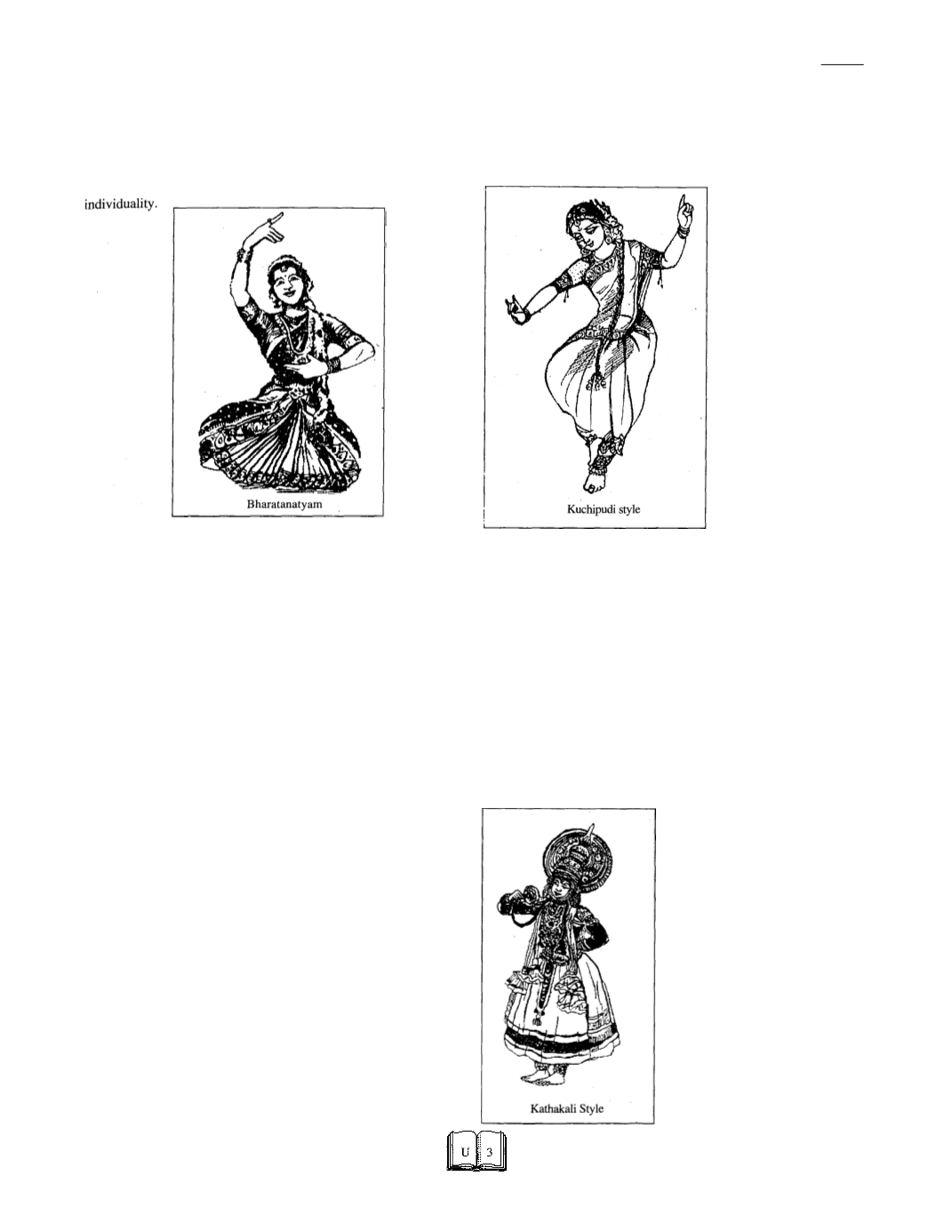

Eternal India
encyclopedia
DANCE
The musical accompaniments of the Bharatanatyam perform-
ance consist of the mridangam (drum) and a pair of cymbals. The
items in the repertoire are
Alarippu, Jathiswara, Sabda, Padams,
Javalis
and
Tillanas.
These items are planned to bring out the
salient features of the style. Similarly in Andhra Pradesh and Kar-
nataka this style evolved on similar lines maintaining its regional
Among the exponents of this style, Meenakshi Sundaram
Pillai, the grandson of Ponniah Pillai, is well known. Kandappa
Pillai, the grandson of Chinnaiah, is another able exponent. Bala-
saraswathi, his disciple, has earned universal acclaim as the grand
lady of Bharatanatyam. Rukmini Devi, who also rendered immense
service to the art founded the Kalakshetra at Adyar in Madras for
the promotion of Bharatanatyam.
While following the pattern of items set by the Tanjore broth-
ers, the Mysore school conforms more strictly to the rules of
pur-
vanga
or preliminary rites, mentioned in the ancient texts. The
repertoire consists of the following items: Pushpanjali followed by
Sabha Pooja, Choornika and Ganesh Vandana. Jetti Tayama,
Dasappa, Kittapa and Puttappa were some of the Gurus while Smt
Venkatalakshamma is a celebrity.
The other forms of Bharatanatyam are Kuravanji and Bhagavat
Mela which are more akin to the ‘
Natya'
defined by Bharata.
Kuravanji is a form of Natya in which six to eight women take
part. The theme of the dance-drama is usually
‘the fruition of the
love of a girl for her hero’
who is either the deity of the temple or the
patron to whom the composition is dedicated. Kutrala Kuravanji is
one of the famous Kuravanjis performed in the temples of Tanjore.
Bhagavat Mela of Tamil Nadu is a form of dance which was
inspired by the Bhakti cult. Only men are allowed to take part in this
dance drama which came into existence in the fifteenth and six-
teenth centuries. These were performed for temple festivals from
the time of Achyutappa Naik, a great patron of art and music.
Melattur, Soolamangalam, Oothukadu and other villages in Tanjore
were famous for the Bhagavat Melas. Some of their dramas are
Prahalada Charitam, Markandeya, Rukmangada, Usha Parinayam
and Harishchandra.
KUCHIPUDI
: Kuchipudi is the dance-drama art ot Andhra
Pradesh in South India. Swami Siddhendra Yogi and Tirtha Nar-
ayan Yati, who were ardent devotees of Krishna, created this
drama by bringing about a synthesis of music, dance and drama for
the purpose of expounding the philosophic truths of the epics and
puranas. Tirtha Narayan Yati wrote an opera
“Krishna Leela
Tarangini”
and his disciple Siddhendra Yogi wrote
‘Parijata-
paharana’
and presented
it at Kuchelapuram, the
present Kuchipudi, with a
group of boys. The play
was received with such
great enthusiasm that the
village itself has been
immortalised as the home
of Kuchipudi style of
dance.
Kuchipudi
was
patronised by the Vijay-
anagar rulers in the 15th
and 16th centuries.
During the course of
its evolution the dramas
were influenced by the
padas of Kshetragna and
other compositions. The
repertoire
of
the
Kuchipudi artistes mainly
consist of Bhava Kalapam, Golla Kalapam, Prahalada Charitam,
Usha Parinayam. Items like
Kannakola
and
Abhishekams
can be
performed as solos, independent of the play.
The exponents : Chinta Venkatratnam and Venkatramayya, the
disciples of Vidya Guru, Vedantam Laxminaryan Shastry, Ven-
dantam Satyanarayan and Chinna Satyam.
Note : In recent years Kuchipudi has gained recognition as a
classical dance form. Hence we find solo dance performers in the
style now like Yamini Krishnamurthy, Raja Reddy, Radha Reddy
and others. Dr. Natraja Ramakrishna has also rendered yeoman
service to the art.
KATHAKALI
: As a classical dance style of Kerala, Kathakali
has evolved from the vernacular and popular dance dramas per-
formed by the rural folk and professional troupes who were inspired
by the myths and legends. The
roots of Kathakali can be traced
back to a thousand and five
hundred years. Kathakali (Katha
= story, Kali = play) is the most
Colourful dance form of India. The
themes of Kathakali are taken
from the epics, the
Ramayana
and the
Mahabharata,
and Hindu
mythology. By tradition the danc-
ers are all male. They wear mask-
like make-up and elaborate cos-
tumes to represent deities, de-
mons,
heroes
and
sages.
Kathakali has assimilated vari-
ous elements of the Aryan and
Dravidian cultures. It also draws
inspiration from the traditional
















